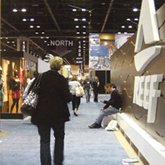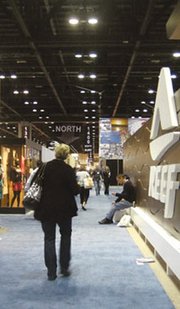Trade Shows Court Skate Industry to Boost Attendance
Skate, always the cool kid in the action-sports industry, has become as popular and elusive as the dreamboat quarterback.
Over the last few years, skate brands—primarily footwear—have slowly slipped away from action sports’ biggest trade shows in favor of smaller regional and skate-focused events geared to their particular sellers and buyers.
Skate’s quick disappearing act was felt acutely at last fall’s round of Surf Expo in Orlando, Fla., and the Action Sports Retailer Trade Expo in San Diego, where there were more skate brands absent than present.
Now, the industry’s big trade shows are making major plays to get skate brands and buyers back on their show floors. “It’s safe to say we want [skate] back,” said Andy Tompkins, vice president of Nielsen Sports Group, which produces ASR. “Skate is one of the founding categories of action sports, and it is part of the ASR DNA.”
Skate footwear brands began exiting the action-sports show for several reasons. First, skate footwear has earlier sales deadlines than apparel brands. Second, the big, national shows are more expensive to attend, which gave more traction to the smaller, more low-key events that started attracting skate footwear vendors.
Aaron Levant, founder of the Agenda show, held in Huntington Beach, Calif., said the larger action-sports trade shows stumbled when they allowed unrelated brands to show alongside core skate and surf brands. “There is no sense of the shows being ’juried.’ They’ll sell a booth to anybody,” he said.
Some industry insiders said they think skate brands felt bullied by the surf industry’s agenda and timeline even though they are a major economic player. In its latest “Retail Distribution Study,” the Surf Industry Manufacturers Association found core skate shops outsold core surf shops by nearly $400 million in 2008. In total, the surf/skate industry rang in $7.22 billion in 2008, with the overall footwear category (which is dominated by skate shoe brands) experiencing the most growth last year, with sales of $1.5 billion—an increase of 15.6 percent from 2006. The hot wheel crowd
For their upcoming events, the big trade shows—such as ASR, Surf Expo and Agenda—are focusing on skate in a big way. Jan. 8–9, the Agenda trade show will debut The Berrics Agenda, a new skate-focused section on the show floor produced in partnership with The Berrics, a Los Angeles–based online branding site for independent skate retailers.
Jan. 14–16, Surf Expo debuts Bangers 4 Bucks, a new skate contest concept that seeks to create relationships between key skate retailers and skate brands. And Feb. 3–4, ASR will partner with the regional Crossroads skate show. The two shows will run concurrently, with ASR at the San Diego Convention Center and Crossroads directly across the street at the PETCO Park parking lot.
Skate, which represents 25 million riders worldwide, represents a huge opportunity for the action-sports industry. “It’s a gateway category [for other board sports] because you can do it anywhere,” said ASR’s Tompkins. “As a business, it has the most access points and its potential is absolutely enormous.”
For that reason, retailers want to see [surf and skate] products side-by-side.
Roy Turner, Surf Expo’s show director, believes that bringing skate brands and buyers back to the industry’s major shows will help unify what many perceive as a fragmented industry. “I look at our show much like a grocery store and think that a broad selection is for the benefit of the buyers,” he said.
He also believes bigger can be better. While smaller, regional skate shows serve a purpose, they also create a new set of problems. Regional shows attract mainly local buyers and don’t give brands a national marketplace. “Does skate need a national marketplace? I think it does [in order to] grow,” Turner said.
The proliferation of smaller shows—which include Crossroads in California; The Moat Show in Tampa, Fla.; and the Focus show in Philadelphia—also makes it hard for brands to participate in all the shows. That reduces the product selection for buyers and makes it hard for them to build unique product mixes, Turner said.
There is also the danger of a fractious surf/skate industry giving up some of its business to “secondary retailers such as Abercrombie & Fitch, Walmart and Target.” Non-industry retailers have shown great interest in surf- and skate-inspired garments and footwear. “If the industry isn’t careful and continues [in-fighting] and doesn’t take part in a national marketplace, it will give up its footprint,” Turner said.
Tompkins agreed. “Having five or six events splinters the manufacturer base and can result in retailers not being able to create a diverse product base, which leaves us more vulnerable to national retailers selling the action-sports category.”
Trade show organizers aren’t the only ones pushing for skate to rejoin the ranks. The Board Retailers Association, serving action-sports retailers, started a petition in 2009 to encourage skate brands to participate in Surf Expo. “It’s the association’s view that retailers are best served by a unified trade show format where they can utilize their limited time and financial resources and cover the many board sport categories their stores often carry in a single location,” said the association’s Melissa Clary.
John Bernards, director of the International Association of Skateboard Companies, said brands, retailers and show organizers need to cooperate in order to strengthen the industry. “Most skate brands want to be out in a parking lot because it’s a more relaxed atmosphere. Unfortunately, retailers don’t always want to write orders in a parking lot,” he said.
Conversely, retailers give brands a hard time by waiting until sales reps come to their stores chasing paper. At many regional shows, reps focus on selling overstock instead of offering the newest goods from their brands—leaving retailers with stale goods and little newness. “The fault lies on all sides. We all have to work together for the industry to work at all,” Bernards said.Skate bait
Trade shows are trying a variety of ways to regain their lost skate business, from paying for top retailers to attend the shows to educational seminars and contests that partner brands with key retailers.
Surf Expo’s Bangers 4 Bucks takes a unique approach to the skate contests that have become de rigueur at board sports shows. The Bangers competition is different because the prizes, instead of going to the skaters, are awarded to the retailers with the strongest skaters. Rather than cash, winners receive product credit from the brands sponsoring the competition. Brands get floor space, retailers get free product. “We wanted a format that was fitting to our audience. For years we have run amateur and pro events much like a park or shop would have, and, while the skating was great, the connection often seemed lost,” Turner said. “Everyone wins.”
Agenda’s Levant said his show has actually seen its skate section grow as ASR and Surf Expo saw their skate rosters shrink. “We were taking steps to create a better environment for them. We’ve had Sole Technology—one of the biggest skate footwear brands—for two years,” he said, and other brands—including Circa, Adidas Skate, DC, Supra and Girls—followed.
As part of The Berrics Agenda program, however, Levant is flying in more than 60 industry retailers, many of them from the East Coast, who might otherwise not have come to the show.
ASR’s Crossroads partnership is part of a larger plan to up its skate credibility. The show, which this season is adding skate-specific educational seminars, moved its summer edition up from September to Aug. 14–16 to better coincide with skate’s sales deadlines.
























